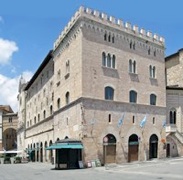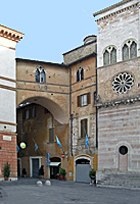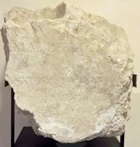
Palazzo dei Canonici
With the minor facade of the Duomo to the left
and the major facade of the Duomo to the right
In 1078, Bishop Bonfiglio made a number of donations to the canons of the ‘Fulginensis ecclesie’ (church of Foligno), evidenced by a document signed in the ‘domo canonicorum’ (canonica). This is the earliest evidence of a canonical community here. The goods donated included two mills, one ‘in castro eiusdem ecclesie’ (in the fortress of this church). The goods donated included two mills, one ‘in castro eiusdem ecclesie’ (in the fortress of this church). It is thus clear that the Duomo and the Canonica were within some kind of fortification that enclosed a reasonable amount of space, enough at least for a water mill. There were shops on the ground floor from at least 1295, when an apothece palatii Canonice posite in platea veteris Comunis Fulginii was documented.

Excavations in Piazza della Repubblica in 1980
From Cruciani and Sensi (below), Table 3.
In its present form, it is bounded by the nave and left transept of the Duomo. It seems that this was the eastern part of a larger original: according to Paola Guerrini and Francesca Latini (referenced below, at pp. 293-5, entry 70):
-
✴Antonio Rutili Gentili documented a larger structure in 1839; and
-
✴the remains of a fortified palace that was excavated in 1980 in Piazza della Repubblica (as recorded by Vladimiro Cruciani and Luigi Sensi, referenced below) probably belonged to the demolished part of the original structure.

The building was remodelled in the 16th century and again in 1764. It owes its current appearance to an extensive restoration carried out in 1923-6 under the auspices of Michele Faloci Pulignani: a number of adjacent buildings were demolished at this time to create a clear view of the façade of the Duomo, and the old bifore windows in the wing next to the minor facade of the Duomo were re-opened. The Museo Diocesano re-opened in 2008 in the top two floors of the palace.
Funerary Inscription (51 - 120 AD)

[---]ius Ẹutych[es]
[---? Pr]imae liberta
[--- qu]artus vicensimus annus
[--- fl]ebilis hic titulus
Read more:
P. Guerrini and F. Latini, “Foligno: Dal Municipium Romano alla Civitas Medievale: Archeologia e Storia di una Città Umbra”, (2012) Spoleto
D. Manconi, “Un Cippo Funerario Romano dalla Piazza Grande di Foligno”, Bollettino Storico della Città di Foligno, 8 (1984) 501-2
V. Cruciani and L. Sensi, “Rinvenimenti Archeologici a Piazza Grande”, Bollettino Storico della Città di Foligno, 6 (1982) 9-16
Return to the page on Monuments of Foligno.
Return to Walk I.



